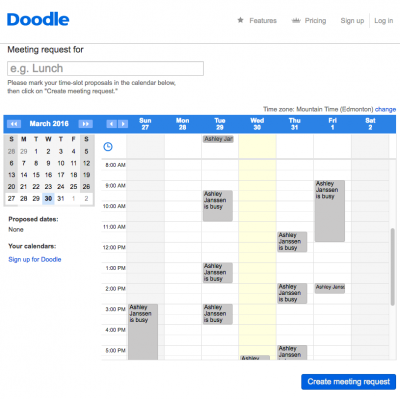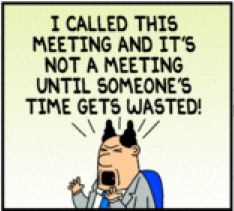Battling the Culture of Busy: Part 2 – Better Meetings
Learn 5 ways to have more effective, intentional meetings.

If the countermeasure to being busy is being intentional, then what can we do to be more intentional in how we choose to spend our time? In this 5 part series on Battling the Culture of Busy, I will provide organization tactics in the following areas: email, meetings, task management, prioritization, and self-care.
After email, for many of us, meetings are another great time vortex in our first-world lives. There is a perception built into our business culture that meetings are a complete waste of time. Yet they are still a big part of our professional lives.

I think one of the biggest reasons why meetings have such a bad reputation is that they often lack structure and purpose. While there can be great benefit to bringing people together to talk through something, without direction, the meeting is likely to fail at achieving its purpose. Below you will learn the following 5 ways to have more effective, intentional meetings.
- Take control of the act of scheduling meetings
- Schedule meetings when you are least productive, on certain days
- Create an agenda with clear outcomes
- Ask yourself WHY before making or accepting a meeting request
- Ask yourself WHO before sending out a meeting request
1. Take control of the act of scheduling meetings
How many times have you emailed someone and asked them to suggest a convenient time and location to meet, only to have them respond saying that they will leave it up to you? So you email back and suggest a time, and then they email back and say they can’t and ask for another option. Then these emails get sent back and forth over and over, eventually ending in a meeting time and location, but only after an exceptional amount of time and effort. You haven’t even had the meeting yet but a bunch of time has already been wasted.
For meetings with multiple people, the planning process gets even more complex as the number of emails sent between everyone increases exponentially.
This whole process actually makes me a little crazy. I think part of it is that people try to be polite to each other by letting the other person decide the meeting time and location, but I think the other part might be laziness. It is easier to defer the decision to others.
I will admit, that in the throes of end-of-day decision fatigue, I will occasionally give in to and ask the regretful question: ‘When/where works for you?’.
It is regretful because there is value in
- Being able to decide to have the meeting at the end of the day so I can go home right after, or
- Setting up two meetings in the same area on the same day so that I am not driving all over the place, or
- Choosing a location that has easy parking so I have one less thing to think about.
Why would I give up that control when I don’t have to? (–> totally a control freak)
Here are two approaches you can try that will help you take control of the situation and be more intentional about when and where a meeting takes place.
Try a web tool

Instead of a plethora of emails, consider using a web tool that lets you identify a selection of times you are available and then have the other party or parties, select from those times. I have used Doodle, before and found it works really well. It syncs with my calendar and I can give the link to the person I am trying to arrange the meeting with and they can see where the breaks in my calendar are.
Some other options you can check out are NeedToMeet and WhenIsGood.
PROPOSE OPTIONS IN YOUR INITIAL EMAIL
Depending on the organization you work for, you might not be able to use a web tool. If that is the case, take control from the first email sent:
- Suggest a minimum of 3 date options
- Suggest a time or range of times on each date
- Suggest a location
2. Be particular about WHEN you schedule meetings
Meetings can be very disruptive to your day. Depending on the time of day they are scheduled, they can pull you out of the zone, and/or completely wipe out your energy for the rest of the day. They can also require a lot of mental effort to plan around because there is not just the meeting itself to consider, but potentially also the time to prepare, travel, park and kill while you wait for a meeting to start — because really, what are you going to get done in the 10 minutes leading up to it? The answer is read Twitter/Facebook/Reddit. So what might help?
Schedule meetings when you are least productive
This might seem counterintuitive, but hear me out. I would argue that it takes different types of energy and concentration to sit at your computer versus in a meeting. If this is true, then it follows that you would want to maximize your productivity for both of those necessary activities.
I have learned the following 5 things about myself:
- I am most productive at my computer between 8:30am – 12:00pm (This is my in THE ZONE time).
- I am least productive at my computer between 2:00pm – 4:00pm (This is my PLZ SEND COFFEE time).
- I am an introvert. Being around other people, no matter how awesome, takes my energy.
- If I take a meeting in the morning, I am even less productive in the afternoon.
- If I take a meeting in the afternoon, even if I am tired, I can still engage and be effective.
This means that I am armed to make intentional decisions about scheduling meetings in the afternoon I know that is my best time.
So when is your best time? To figure that out you can ask yourself:
- When am I most productive doing individual work during the day?
- When am I least productive doing individual work during the day?
- Does being around other people give or take my energy (extrovert vs. introvert)?
For example, if you are an extrovert, you are likely energized by being around others so having morning meetings might give you the energy to pull through that post-lunch coma and have a productive afternoon.
If you can figure out the answers to these questions, it will help you manage your energy and stay in the zone.
Schedule meetings on certain days of the week
The purpose here is intentionally setting aside days for highly focused time with no meetings. It is a balance between energy management and reducing daily interruptions. Whether or not you can practice it will depend a lot on the volume of meetings you have in your role. In my role, I usually have 5-10 meetings a week so it works for me.
I love looking at my calendar and seeing a day where I have no meetings because I will sit down at my desk and know that I can focus for an entire day. On the flip side, when I realize I have booked five meetings in a single day, I know it is going to be a long one and I have probably overbooked myself. Again, introvert problems.
For me, I like having Fridays open so I will try to have most of my meetings mid-week, keeping in mind that this is not always possible.
My suggestion is to pick 1- 2 days a week that you try not to schedule any meetings on, and balance your other meetings across the other days.
3. Create an agenda with clear outcomes

I can already see some of you rolling your eyes at having to create an agenda for every meeting. Sounds kind of efforty, doesn’t it? Truthfully though it is very little work with exceptional potential for return on effort. Meetings with no structure are harder to keep on track, and often waste more time. People go off on tangents and end up going down lines of conversation that don’t matter.
Agendas can provide structure by setting the expectation of what you want to achieve. By stating the meeting purpose and objectives upfront (e.g., brainstorming, decision making, etc.), you are setting the tone.
OUR AGENDAS GENERALLY FOLLOW THIS STRUCTURE:
- Project, date, and attendees.
- Active documents of note – We use Google docs and spreadsheets so we link to other documents that might be of use or inform the conversation.
- Action items – These are updates on the status of past items that someone is accountable for. They are in one of the following states: DONE, TODO, IN PROGRESS, or TABLED.
- Discussion items – These are the points to be discussed at today’s meeting. As we go through the discussion items we add new action items with a specific person assigned to each.
- Tabled items – Things that we want to remember to return to but are not an immediate priority.
For recurring meetings, we create a copy of the last agenda and update it prior to the next meeting.
By itself, an agenda will not keep a meeting under control but it provides the person leading the meeting with a framework for managing the conversation and being intentional about its purpose.
Creating an agenda makes a lot of sense for more traditional office meetings, but what about less formal situations, like coffee meetings where an agenda wouldn’t really be appropriate? In those situations, while you may not want to have a piece of paper or laptop out with a line-by-line discussion list in front of you, it is even more important to know what you want to get out of the meeting. Coffee meetings are often meet and greet or networking opportunities, but what does that mean exactly? This brings me to my next point…
4. Ask yourself WHY before making or accepting a meeting request
When my role in my company first transitioned to business development I knew that it was important in my role to meet people so I set up tons of coffee meetings. I knew these were smart/interesting/awesome people who I wanted to know, but I would leave many of the meetings with no clear actions and just a vague sense that perhaps I was missing something. The meetings were not a total waste of time since I had many wonderful conversations, but I think that the time could have been better spent.
I didn’t really have a concrete answer for WHY I was meeting with them.
Over the years, as I have become more intentional with my time, and in turn how I treat other’s time. This means I am more discerning about the meetings I request or accept. For each meeting I ask:
What is the purpose of this meeting and who does it benefit?
If you can’t clearly articulate why you are going to a meeting, you probably shouldn’t go at all. Just like when you create an agenda, knowing the outcome you hope to achieve makes all the difference. Is it for mentorship, building a relationship, discussing a particular issue, collecting information, etc. What kind of action items do you think will come from it? Would an email suffice?
Asking who will benefit is also important because if the benefit is more for the other person/people you need to decide if you are in a position to give your precious time.
Does this meeting fit with my values and priorities?

This might seem like a weird question to ask but the reason I think it is important is that it will guide the types of meetings you will accept. For example, I have a relationship with Career and Placement Services at the University of Alberta and I occasionally get requests from students to meet and talk about my career path with them.
The benefit gleaned from these meetings is for the student. It will take an hour of my time I could be doing something else. However, mentorship is something that I personally highly value and the time that I share in the meeting, while not directly benefiting me, is something that I am happy to give because it fits within my values.
On the other side of the spectrum, I have been invited to some networking group meetings where the exchange of business cards is a major driver. While there is nothing wrong with those types of meetings, they are not high on my priority list, nor do they really fit in the kind of meetings that I find valuable.
If I create/accept this meeting, how does it impact the rest of my day/week?
This question echoes some of my earlier points about being particular about when you schedule meetings. If your schedule is starting to feel tight, or you have a lot of other responsibilities on your plate, it is ok to push something back a few weeks. You are not saying ‘no’, you are just saying ‘not now’. By delaying it, you are instead giving yourself time to give the person and the meeting the energy and attention they deserve, without burning yourself out.
By asking these questions for your own meetings, you can make sure that the meetings you do attend are a good, or at least purposeful, use of your time.
5. Ask yourself WHO before sending out a meeting request
Finally, you know when you want to meet, why you want to meet, and you have an agenda ready to roll. Now you need to make sure the right and necessary people are in the room.
I strongly believe that for most meetings, the ‘more the merrier’ approach is not applicable. The more people you have in the meeting, the more voices, opinions, and personalities there are to manage. This is not necessarily a bad thing, but it opens the meeting up to greater opportunity for disruption, getting off topic, and going over time.
Way back in my government days (many, many moons ago), we would have these monolithic monthly staff meetings. They would last several hours and have at least 15 people in the room. I dreaded these meetings. They were everything that Dilbert comics mock. They were the kinds of meetings where you had to strategically plan bathroom breaks to prevent yourself from falling asleep. In my mind, there was no real reason to have all those people in that room at once. Most of them (including me) didn’t add value and had could have been informed of some of the items via a simple email.
I often think of those meetings when I put together a meeting request, and instead of inviting ALL THE PEOPLE, for each invitee, I ask:
- What is the role this person performs in the meeting?
- What is the benefit of having this person in the meeting?
- Is this a good use of their time?
The idea is to have the right people, in the right seats, at the right time.
Summary
By being more intentional about how you schedule your meetings, when you take your meetings, how you run/organize your meetings, and who you include in your meetings, you can make a big difference in the amount of time your spend and the value you get out of them.
Think about some of the meetings you have in the next few weeks and consider if any of these tactics might help make it more impactful.
Share
Ashley Janssen

Productivity consultant, writer, speaker, serial entrepreneur, chaos calmer, introvert, cat-lady. Lover of books, fitness, old fashioned’s, basketball, and video games.
Follow me on
Twitter
or
LinkedIn.
Hire me for
1 on 1 productivity consulting
or
speaking.
Related articles

9 Ways to Get More Out of Networking by Being Intentional

8 Ways to Set Boundaries Around When You Schedule and Accept Meetings


Comments ()